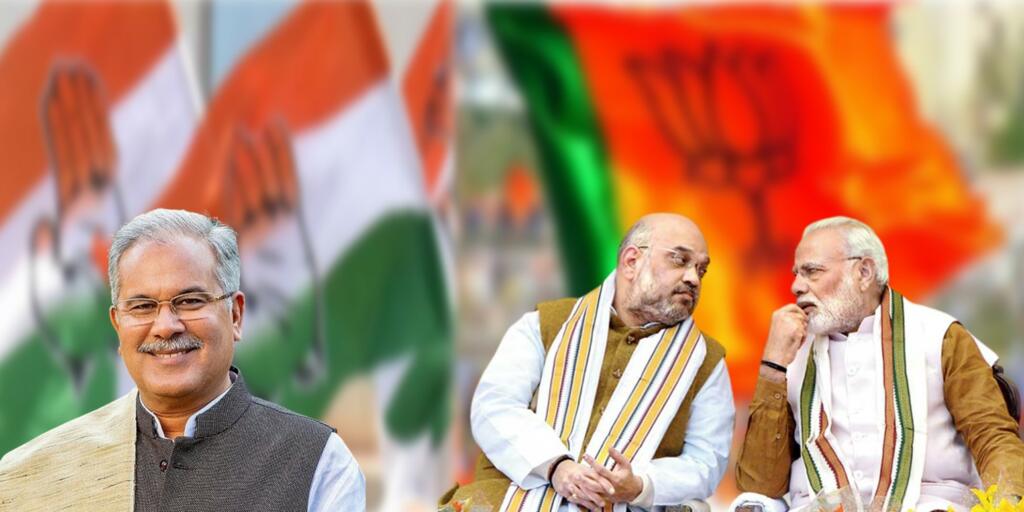2023 is a year of high stakes in the political domain as general elections are due for 2024. For parties like the Bhartiya Janata Party, the battle is for retention of power and strategising for the 2024 game of throne. However, for the ones like the Indian National Congress, the assembly elections are a battle for survival, which if not won may decimate the party that already lies in peril. Chattisgarh is one such battle, where the Congress would be contesting for survival and maintaining the status of a national party. But, for now Chattisgarh seems to be a hard nut for the BJP to crack despite have ruled the state for 15 years.
The formation of Chattisgarh and the politics around it
Senior BJP leader Atal Vihari Vajpayee’s signature in politics was achieving pragmatic consensus. The same was manifested when the Atal Vihari Government created three new states Chhattisgarh, Uttarakhand and Jharkhand in 2000 without even a ripple of disturbance. Chhatisgarh comprises 16 districts of the undivided Madhya Pradesh, and contributed 28.58 per cent of the state’s revenue. The states were then divided due to socio-political reasons and not on linguistic basics, and all complained of exploitation. The case of Chhattisgarh was no different. The areas of Chhattisgarh were not only exploited by the regional powers but also the centre as forest and mineral wealth is under national control. Just like the social status of Chattisgarh, the politics was also complicated.
With the formation, Ajit Jogi, the leader of the 48 member Congress Legislature party was sworn in as the chief minister. In the 90 member assembly, the Bhartiya Janata Party had 36 members and the Bahujan Samaj Party had three. Then happened the first election which changed the course of history.
Begins the rule of BJP
Legislative assembly elections were held in December 2003. The first elections of Chhattisgarh paved the way for Bhartiya Janata Party’s rule. In the first election, the incumbent Chief minister Ajit Jogi lost and BJP’s Raman Singh was sworn in as the chief minister of the state. The BJP had swept 50 seats, while the Congress was reduced to 37.
Read more: BJP ticks all the boxes for Madhya Pradesh elections 2023
In 2008, defeating anti-incumbency and factionalism, the Bhartiya Janata Party returned to power. The assembly election has a lot to do with the social sector spendings done by the Raman Singh government. The BJP has contested and won with the slogans of “development” and “fight against red terror”. The BJP presented itself as the strong force capable of countering the Naxalite issue. One more aspect to be noticed, is that in 2008 BJP’s victory was backed by support of adivasis especially the Gond tribes.
The Modi wave and the state of Chhattisgarh
The next election in 2013 and with the centrally usurping Modi wave, the Raman Singh government retained the state for the BJP. In the 2013 election what went unnoticed was that Congress has prepared its tribal support base. As it had won a majority of tribal seats, 18 out of 29. The region previously ought to be a BJP stronghold. However, in 2018 the 15 year long rule ended for BJP in the state.
Read more: BJP will win Rajasthan: The most comprehensive analysis
It was after the struggle of 15 years that the Congress was able to win the state, thus ending the 15 year long rule of BJP. The Congress scored 68 out of 90 seats with 43 per cent votes. What complemented Congress’ win was the Jogi-Mayawati alliance. The ex CM’s JCC joining hands with the BJP was supposed to harm the Congress, however, it ended up helping Congress by taking up the Dalit support away from the BJP
The ‘Caste Factor’
The ST base moving away from the BJP, with the party it has been consistently associated with makes the analysis of social structure of the state and predict the upcoming results becomes bit easier. Out of the 90 seats, 39 are reserved, 29 for the Scheduled tribes and 10 for the Scheduled castes. Yes, like most of India, Chhattisgarh is not untouched with caste politics.
The OBC population constitutes 41 per cent of the population of the state, thus giving the community an edge. OBC and the upper caste have been a traditional vote bank of the BJP. The graph now seems to be changing with the rise of Sahus in the state, which form the 20% of the OBC community, forming the bulk of the OBC votes in the state. The Congress in recent times has been catering to the Sahus to protect its Chhattisgarh fortress. With the shifting base of SCs, STs and the Sahus among the OBC, the Congress finds its position secured. The same was evident in the celebration of bypoll victories.
Why Congress’ victory in bypolls do not guarantee success
While the Congress was seen celebrating the recently held Bhanupratapur bypolls, the victory can’t guarantee a smooth sail for the Congress in 2023. The bypoll was necessitated by the death of Manoj Mandavi, and was won by her wife Savitri. However, the mandavi has been a three time MLA and has been winning elections since the region was a part of Madhya Pradesh. Thus, it can be said that Congress won the Bhanupratapur bypoll solely on the personality cult of Mandavi and sympathy wave. Thus, the bypoll can’t be a litmus test for the Bhupesh Baghel government.
Support TFI:
Support us to strengthen the ‘Right’ ideology of cultural nationalism by purchasing the best quality garments from TFI-STORE.COM
